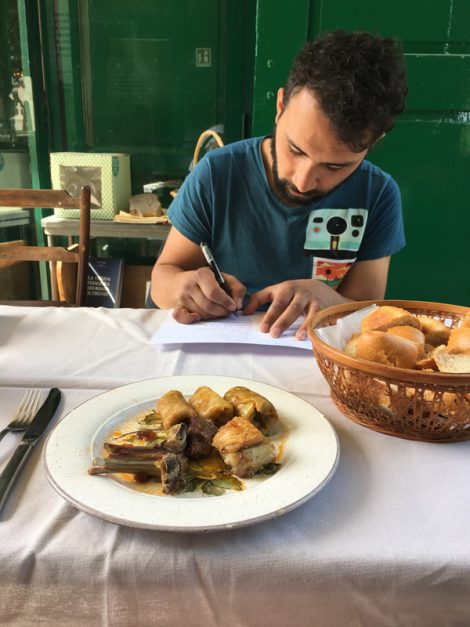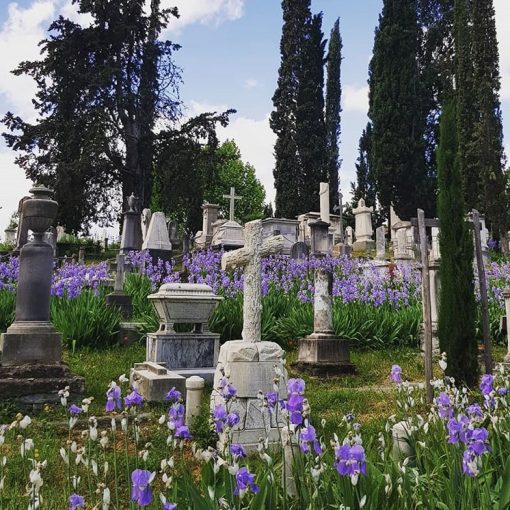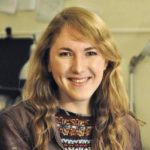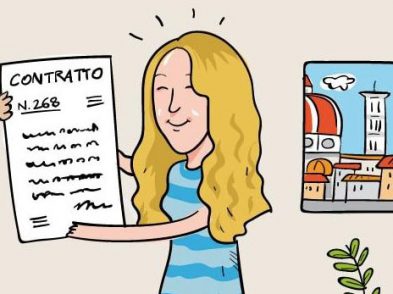It’s Orthodox Easter Sunday and a small group has gathered for a celebratory meal in Florence’s Swiss-owned “English” cemetery. Julia Bolton Holloway, the space’s longtime resident tenant, holds up a hard-boiled egg dyed red, thumbing it thoughtfully. “Brunetto Latini, Dante’s teacher, said that nothing was so natural as a round object,” she muses.
Her meditative comment could be read as pretentious in any other context. But no one at the table blinks an eye, hearing it from the kind-tempered, habit-wearing medieval scholar. Holloway quickly explains, “Round things are so often found in nature because they can hold or enclose so many things at once.”

Orthodox Easter snacks at the English Cemetery / Ph. Mary Gray
One wonders if Holloway has given much thought to the oval shape of “her” cemetery. Burial site to Elizabeth Barrett Browning and Walter Savage Landor, the cemetery is an egg-like island surrounded by piazzale Donatello’s swirling traffic. Well in line with Latini’s outlook on round objects, it holds many stories at once—to say it “encloses” them, however, would be a poor choice of words.
Despite Holloway’s nun’s habit, no specific religious order is among the island’s “held” communities. “I’m a hermit, so I’m a freelancer,” Holloway laughed a few weeks prior to Easter, when we met for the first time. “I’m a maverick Christian.”
Holloway left England and her life as a doctorate-holding, divorced Anglican nun, “fleeing from an awful experience,” she says. The cemetery indirectly came into her care through her work editing that prominent Englishwoman enamored with Florence—Elizabeth Barrett Browning—for Penguin.
High-profile publisher notwithstanding, Holloway was nearly penniless, but found mutual empathy in connecting with members of Florence’s Roma community, the traditionally itinerant group frequently, and often pejoratively, referred to as “gypsies.” For nearly two decades, Holloway has advocated on behalf of Florence’s Roma population and cultivated reciprocal relationships, anchored in the cemetery. Roma workers tend to the tombs, provide maintenance work and plant wild irises—in their prime this time of year—while Holloway offers literacy training (“Alphabet School”) and nourishing lunches.

Alphabet School student Mihai finishes work ahead of lunch.
/ Ph. Mary Gray
Today is Orthodox Easter, though, so Roma couple Diamanta and Ionel are doing the cooking, moving between the kitchen and the school table as Holloway leads an abbreviated lesson. Ionel’s boyish younger brother Mihai rings the gate bell a few minutes late, taking a seat and a worksheet with the Lord’s Prayer typed out in Rumeno, Romani and Italian. He writes his name and dutifully copies the prayer text until Ionel and Diamanta storm the study hall with generous platefuls of sarmale—meat-filled cabbage rolls. Chatter in English, Italian and asides in Romani, mostly lighthearted talk of Facebook videos and favorite cities, dominates the meal, though Holloway and Ionel each occasionally interject with something a bit sager.
The small feast the group is savoring is traditionally Romanian, yet hardly an indication that the cooks have a seamless relationship with the cuisine’s origin country. (Ditto for that dove-shaped Italian Easter staple, the colomba cake, which awaits us for dessert). Roma presence in Europe dates back 1000 years, to when groups first migrated to the Balkans¹ from the Indian sub-continent². Today the EU Agency for Fundamental Rights estimates the Roma to number 10 to 12 million, some six million of whom live within the EU, making them the largest ethnic minority in Europe.
With this huge sect of the population largely confined to life on economic, social and even spiritual margins (refusal of church communion is common, even in Romania), in 2011 the European Commission released a communication on an EU framework for national Roma integration strategies. An introductory line describes social and economic integration as “a two-way process which requires a change of mindsets of the majority of the people as well as of members of the Roma communities.”
Hyper-specific it is not, but it is not at odds with Holloway’s approach; when asked if she sought teaching assistants or additional advocates, she claimed she instead needs “changing attitudes,” gesturing toward the framed photographs of jovial Roma celebrations lining her library.

Irises planted by Roma workers in Florence’s English Cemetery. / Ph. Gina
Mazza @florengina
Attitudes are more easily changed, of course, when status-quo maintainers can point to clear “efforts” from the marginalized. Holloway waxes poetic about the photographs, how they bring out the inherent beauty of the Roma, but also acknowledges that the cemetery owners and her own Social Security funds have limits. “One woman, Julia, I had to tell her to stop coming to school,” she says. “A professional beggar who would have a baby a year to do her begging.” But most students, she adds, know “work brings dignity.”
Daniel, absent on Easter, is a textbook example of the European Commission’s talk of “two-way process,” a beacon Holloway, in her advocacy, holds up to the skeptics. The grandson of a famed coppersmith in his corner of Romania, he “inherited those ancestral tools,” Holloway says. In a single summer, he conserved all the cemetery’s rusting Victorian ironwork, covering it with grey varnish and catching the attention of an Opificio delle Pietre Dure restorer, under whom he did an apprenticeship. He shaped “green cities” proposals that Holloway presented at two past State of the Union conferences in Florence, during scheduled EU Labor Market and Migration Policy debates. Daniel’s vision for the “green cities” would include family-friendly housing and landscaping built and maintained by out-of-work EU citizens, together with Roma (many of whom are, in fact, EU citizens) and migrants to foster social understanding. A quick glance at the cemetery’s intricate flowerbeds and cleanly-cut pathways shows a knack for landscaping is not lacking.
Easter lunch is wrapping up and Ionel, the cook, asks if I’ve poked around the cemetery beyond the nearby daffodil bulbs. Have I taken a walk to see the tombs? Sheepishly, I tell him I haven’t, though I know it’s a “must” for the Tea with Mussolini-tinted tribe of Anglo residents in Florence to which I apparently belong. We start clearing the dishes and carrying them to the kitchen, but he cuts me off at the door. “No, go visit the cemetery,” he says in English. “You are our guest.”







